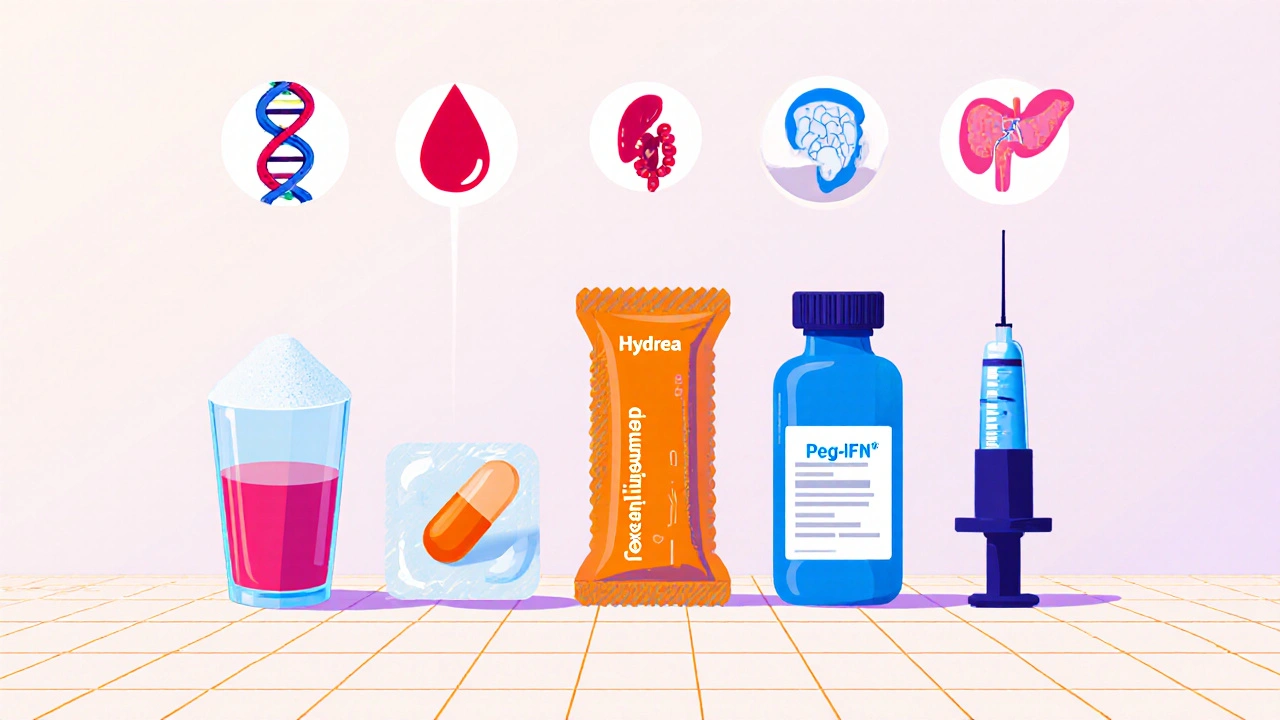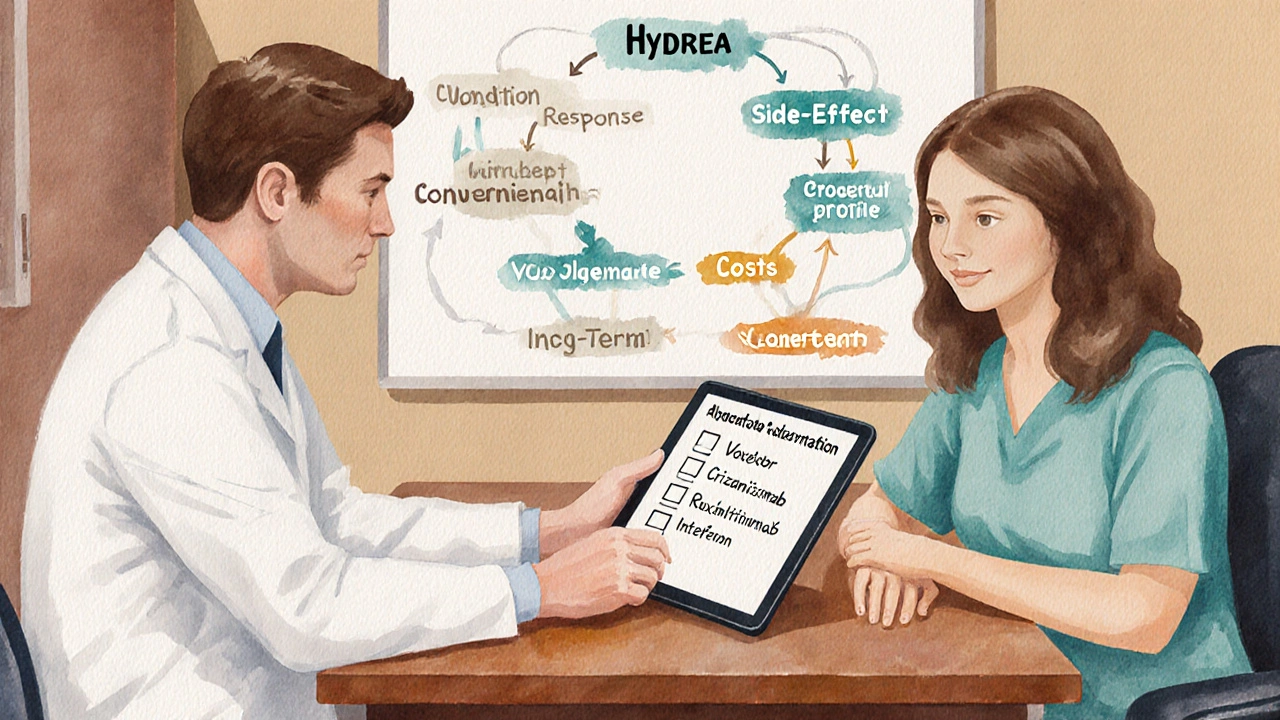Hydrea Alternative Decision Tool
This tool helps you evaluate whether Hydrea (hydroxyurea) is the best treatment option for your specific situation or if you might benefit from exploring alternatives. Answer the following questions based on your condition and preferences.
Your Condition
Your Current Treatment
Your Treatment Preferences
Recommendation
Key Takeaways
- Hydrea (hydroxyurea) works by reducing DNA synthesis, making it useful for sickle cell disease and certain blood cancers.
- Newer agents such as voxelotor, crizanlizumab, and L‑glutamine offer targeted benefits with fewer side‑effects for sickle cell disease.
- For myeloproliferative neoplasms, ruxolitinib and interferon‑α provide disease‑modifying alternatives.
- Choosing an alternative depends on the specific condition, side‑effect tolerance, dosing convenience, and cost.
- A quick checklist can help patients and clinicians decide when to stay on Hydrea or switch to another therapy.
When you hear the name Hydrea (hydroxyurea), you probably picture a pill that’s been around for decades. It’s a cheap, oral drug that slows down cell division and raises fetal hemoglobin, which helps people with sickle cell disease (SCD) and certain blood cancers. But the pharmaceutical landscape has changed. New drugs promise better symptom control, fewer lab abnormalities, and more convenient dosing schedules. This guide walks you through how Hydrea stacks up against the most talked‑about alternatives in 2025, so you can see where it still shines and where another option might fit better.
What Is Hydrea (Hydroxyurea)?
Hydroxyurea is a ribonucleotide reductase inhibitor that interferes with DNA synthesis. By limiting the production of new red blood cells, it reduces the rapid turnover of immature cells that characterize conditions like polycythemia vera and essential thrombocythemia. In sickle cell disease, a secondary effect-up‑regulation of fetal hemoglobin (HbF)-dilutes the sickle hemoglobin (HbS) and lessens vaso‑occlusive crises.
Typical dosing for SCD starts at 15mg/kg daily, adjusted to keep the mean corpuscular volume (MCV) around 100fL. For myeloproliferative neoplasms (MPNs), doses range from 1g to 2g per week, split into two or three doses. Monitoring includes blood counts every 2-4weeks until stable, then every 3months.

When Do Clinicians Look for Alternatives?
Even though Hydrea is cheap and works for many, several red flags push doctors toward other agents:
- Persistent low blood counts (neutropenia, thrombocytopenia) that limit dose escalation.
- Uncontrolled pain crises in SCD despite optimal HbF rise.
- Long‑term risk concerns, such as potential leukemic transformation in high‑risk MPN patients.
- Patient preference for injections or less frequent dosing.
- Insurance formularies that favor newer, branded therapies.
When any of these issues appear, it’s time to compare Hydrea with the newer options.
Comparison Table: Hydrea vs. Major Alternatives (2025)
| Agent | Primary Indication(s) | Mechanism | Typical Dosing | Major Pros | Major Cons |
|---|---|---|---|---|---|
| Hydrea (hydroxyurea) | Sickle cell disease, polycythemia vera, essential thrombocythemia | Ribonucleotide reductase inhibition → ↑ HbF, ↓ cell proliferation | 15mg/kg daily (SCD) or 1-2g weekly (MPN) | Oral, inexpensive, long‑track record | Myelosuppression, possible leukemic risk, frequent lab monitoring |
| L‑glutamine (Endari) | Sickle cell disease | Reduces oxidative stress in red cells | 0.3g/kg twice daily (oral powder) | Improves pain‑crisis frequency, well‑tolerated | Requires multiple daily doses, modest efficacy compared to Hydrea |
| Voxelotor (Oxbryta) | Sickle cell disease | Hemoglobin S polymerization inhibitor | 1500mg daily (oral) | Increases hemoglobin, reduces hemolysis | Costly, limited impact on pain crises alone |
| Crizanlizumab (Adakveo) | Sickle cell disease | Anti‑P‑selectin monoclonal antibody | 5mg/kg IV every 2weeks then monthly | Strong reduction in vaso‑occlusive episodes | IV administration, infusion reactions, insurance hurdles |
| Ruxolitinib (Jakafi) | Myelofibrosis, polycythemia vera (hydroxyurea‑resistant) | JAK1/2 inhibition → ↓ cytokine signaling | 10-25mg BID (oral) | Improves splenomegaly and symptoms, oral | Anemia, infections, higher price |
| Interferon‑α (Peg‑IFN‑α) | Polycythemia vera, essential thrombocythemia | Immunomodulation → reduces malignant clone | 45µg weekly (subcutaneous) | Potential disease‑modifying effect, no leukemic risk | Flu‑like symptoms, injection site reactions |
| Anagrelide | Essential thrombocythemia | Phosphodiesterase‑3 inhibition → ↓ platelet production | 0.5-2mg BID (oral) | Effective platelet control, oral | Cardiac toxicity, palpitations, edema |
| Busulfan | Chronic myelogenous leukemia (CML) - older protocols | Alkylating agent → DNA cross‑linking | 0.8mg/kg IV daily for 4days (induction) | Potent cytoreduction | High toxicity, not first‑line for most MPNs |
Deep Dive into the Top Alternatives
L‑glutamine (Endari)
L‑glutamine is an amino acid supplement that combats oxidative damage in sickle red cells. Clinical trials (Phase III, 2023) showed a 26% reduction in pain‑crisis days versus placebo. It’s taken as a flavored powder mixed with water. The main draw is its safety profile-most patients experience only mild gastrointestinal upset. However, the twice‑daily schedule can be inconvenient, and the hemoglobin boost is modest compared with Hydrea’s HbF effect.
Voxelotor (Oxbryta)
Voxelotor directly binds to the α‑chain of hemoglobin, preventing the sickling cascade. In the HOPE trial (2022), average hemoglobin rose by 1.1g/dL, and markers of hemolysis fell. It’s a once‑daily oral pill, which patients love. The downside is its price-often five times the cost of generic hydroxyurea. Moreover, while it improves lab values, the impact on crisis frequency is less pronounced than that of Hydroxyurea or Crizanlizumab.
Crizanlizumab (Adakveo)
Crizanlizumab is a monoclonal antibody that blocks P‑selectin, a molecule that helps sickled cells stick to blood vessel walls. The SUSTAIN trial (2021) reported a 45% drop in annual vaso‑occlusive events. It’s given via IV infusion every two weeks for the first three doses, then monthly. Patients who can tolerate infusions often see the biggest reduction in pain crises. The cons are the infusion logistics, possible allergic reactions, and higher out‑of‑pocket costs.
Ruxolitinib (Jakafi)
Ruxolitinib targets JAK1/2, dampening the cytokine storm that drives splenomegaly and constitutional symptoms in myelofibrosis and hydroxyurea‑resistant polycythemia vera. In the COMFORT‑I trial (2020), >50% of patients reported a ≥35% spleen volume reduction. It’s an oral tablet taken twice daily, which many find easier than daily hydroxyurea dosing. Side effects include anemia, thrombocytopenia, and increased infection risk, so blood counts must be watched closely.
Interferon‑α (Peg‑IFN‑α)
Pegylated interferon‑α works by boosting the immune system’s ability to recognize and suppress the malignant clone in polycythemia vera and essential thrombocythemia. Studies (2024) show durable molecular remissions in up to 30% of patients after 3years. It’s administered subcutaneously once a week, which some patients dislike. Flu‑like symptoms are common during the first weeks but usually subside. The advantage is the potential disease‑modifying effect without the leukemic risk linked to hydroxyurea.
Anagrelide
Anagrelide reduces platelet production by inhibiting phosphodiesterase‑3. It’s effective for controlling platelet counts in essential thrombocythemia, especially when patients cannot tolerate hydroxyurea. However, cardiotoxicity (tachycardia, palpitations) and fluid retention are notable concerns, requiring baseline cardiac evaluation and periodic ECGs.
Busulfan
Busulfan is an alkylating agent that was once a mainstay for chronic myelogenous leukemia before tyrosine‑kinase inhibitors took over. It still finds niche use in aggressive myeloproliferative disease where rapid cytoreduction is needed. The drug carries a high risk of pulmonary fibrosis and requires therapeutic drug monitoring. Because of its toxicity, it’s rarely chosen as a first‑line alternative to hydroxyurea.

Decision‑Making Checklist: Stay on Hydrea or Switch?
- Condition: SCD vs. MPN vs. other indications.
- Response to Hydrea: Adequate HbF rise / blood count stability?
- Side‑Effect Profile: Is myelosuppression limiting dose?
- Convenience: Desire for oral daily vs. monthly infusion?
- Cost & Insurance: Generic Hydroxyurea (low cost) vs. branded alternatives (higher copay).
- Long‑Term Goals: Symptom control only, or disease‑modifying remission?
If you tick most boxes for “Hydrea works, tolerable, affordable,” staying on it makes sense. If you hit three or more red flags, discuss an alternative using the table above.
Practical Tips for Switching Therapies
- Coordinate with your hematologist to obtain baseline labs (CBC, liver/kidney function).
- Ask for a wash‑out period only if moving to a drug with overlapping toxicity (e.g., from Hydroxyurea to Busulfan).
- Set up a monitoring schedule: Most alternatives still need periodic CBCs; biologics may need liver enzymes.
- Check your pharmacy’s specialty program for infusion drugs-some offer home nursing.
- Keep a symptom diary for at least 3months to objectively compare efficacy.
Frequently Asked Questions
Is hydroxyurea still the best first‑line treatment for sickle cell disease?
Will Hydroxyurea work for all patients?
Hydroxyurea benefits about 70% of patients by raising HbF and cutting pain crises. Those who don’t see a rise in HbF after 6months, develop severe myelosuppression, or can’t tolerate daily pills should discuss alternatives such as voxelotor or crizanlizumab.
How do I know if I’m a candidate for crizanlizumab?
Candidates are usually adults with ≥2 vaso‑occlusive crises per year despite optimal hydroxyurea dosing. Insurance pre‑authorization is common, so a doctor’s letter outlining the unmet need helps.
Can I mix hydroxyurea with newer drugs?
Combination therapy is possible but must be individualized. For example, low‑dose hydroxyurea can be paired with interferon‑α in polycythemia vera to enhance disease control while limiting each drug’s toxicity.
What monitoring is required for ruxolitinib?
Baseline CBC, liver enzymes, and a lipid panel. Then CBC every 2‑4weeks for the first 3months, adjusting dose if hemoglobin drops below 10g/dL or platelets fall under 100×10⁹/L.
Is the cost difference between hydroxyurea and voxelotor justified?
Voxelotor’s price is roughly $300‑$350 per month versus under $20 for generic hydroxyurea. If a patient’s main issue is low hemoglobin rather than pain crises, voxelotor may be worth the expense. Otherwise, insurance often favors the cheaper option.
Choosing the right therapy is a balance of efficacy, safety, convenience, and cost. By comparing Hydrea side‑by‑side with the 2025 alternatives, you’ve got a clearer picture of when to stay the course and when a switch could improve quality of life.

Fae Wings
October 14, 2025 AT 22:12Wow, reading through that guide feels like unwrapping a massive medical treasure chest 😭. The way the author laid out the decision checklist really helps patients see the big picture without getting lost in jargon. I especially love how they highlighted the balance between cost and convenience – those are the real‑world concerns we all juggle. If you’re shaking your head wondering whether to stick with Hydroxyurea or try something shiny, just remember you’re not alone in this maze. 🌟
Anupama Pasricha
October 15, 2025 AT 00:59The comparison table does a solid job of laying out mechanisms side by side, which is helpful for clinicians who want a quick reference. Notably, the emphasis on monitoring requirements across all agents underscores patient safety. It’s also prudent to mention that insurance formularies can dictate which newer drugs are actually accessible. Overall, the guide offers a pragmatic roadmap for decision‑making in everyday practice.
Bryce Charette
October 15, 2025 AT 05:09Good read, the breakdown of each alternative’s pros and cons is spot on. The note about myelosuppression with Hydroxyurea being a key red flag is especially relevant for SCD patients. Also, the practical tips for switching therapies, like getting baseline labs, are very useful. Keep the info coming, it’s valuable for both patients and providers.
karthik rao
October 15, 2025 AT 10:42While the table is thorough, it glosses over the long‑term leukemic risk associated with Hydroxyurea, which remains a contentious point in hematology. 📈
Ashika Amirta varsha Balasubramanian
October 15, 2025 AT 17:39From a philosophical standpoint, the decision to remain on a legacy drug versus embracing a novel therapy mirrors the classic tension between tradition and innovation. One must weigh not only clinical efficacy but also the symbolic weight of continuity in a patient’s therapeutic journey. The guide’s inclusion of cost considerations reflects the ethical imperative to treat patients equitably, regardless of socioeconomic status. Moreover, the emphasis on patient‑reported outcomes aligns with a more holistic view of health. It is refreshing to see a resource that does not reduce treatment to mere numbers but invites a broader contemplation of quality of life. In short, the guide invites us to reflect on the deeper narratives behind each prescription.
Jacqueline von Zwehl
October 16, 2025 AT 01:59Great summary.
kathy v
October 16, 2025 AT 11:42Let us consider, dear reader, the grand tapestry of therapeutic evolution and how Hydroxyurea, that humble, decades‑old molecule, has stood the test of time while newer agents sprint onto the stage with promises of convenience and precision. First, the economic dimension cannot be ignored; Hydroxyurea’s generic status translates into a price point that few other hematologic drugs can match, making it indispensable in low‑resource settings where even a modest co‑pay can be prohibitive. Second, the pharmacodynamic profile of Hydroxyurea, with its ability to increase fetal hemoglobin, remains unrivaled in its simplicity and efficacy for many patients with sickle cell disease, especially when adherence to daily oral dosing is feasible. Third, the safety concerns-myelosuppression, potential leukemic transformation-though real, are manageable with diligent laboratory monitoring, a practice that has become routine in modern hematology clinics. Fourth, the psychological comfort of continuity should not be dismissed; patients often develop a sense of trust in a medication that has demonstrated consistent benefit over years of use. Fifth, the newer monoclonal antibodies, such as Crizanlizumab, while effective in reducing vaso‑occlusive crises, impose logistical burdens of infusion centers and potential infusion reactions, which can be a deterrent for many. Sixth, the oral agents like Voxelotor, though convenient, carry a hefty price tag that limits accessibility for many, and their impact on crisis frequency is still under scrutiny. Seventh, the role of interferon‑α in polycythemia vera offers a disease‑modifying approach, yet its flu‑like side effects and subcutaneous administration present adherence challenges. Eighth, the JAK inhibitor Ruxolitinib provides symptom relief in myelofibrosis, but its hematologic toxicities require careful dose titration. Ninth, the advent of gene therapy looms on the horizon, promising potentially curative outcomes, yet remains experimental and out of reach for the majority. Tenth, the ethical dimension of prescribing high‑cost therapies when a low‑cost, effective alternative exists must be weighed against individual patient preferences and clinical nuances. Eleventh, real‑world data continually highlight that a substantial proportion of patients remain well‑controlled on Hydroxyurea, reinforcing its role as a first‑line cornerstone. Twelfth, clinicians must navigate the complex interplay of insurance formularies, patient comorbidities, and lifestyle considerations when recommending a switch. Thirteenth, shared decision‑making tools, like the one presented in the guide, empower patients to voice their values and concerns. Fourteenth, ongoing research may soon elucidate biomarkers that predict response to specific agents, further personalizing therapy. Fifteenth, until such precision tools are commonplace, the pragmatic approach of evaluating response, side‑effects, cost, and convenience remains paramount. Finally, the choice between staying on Hydroxyurea or transitioning to an alternative is not binary but a nuanced, patient‑centered journey that demands thoughtful dialogue, continual reassessment, and compassion.
Jorge Hernandez
October 16, 2025 AT 22:49Totally feel ya 🙌 staying on what works is legit but always good to peek at the new options too
Michael Dion
October 17, 2025 AT 11:19yeah the table is good but could've used less fancy words maybe
Trina Smith
October 18, 2025 AT 01:12Interesting perspective on tradition vs innovation – it reminds us that medicine is as much art as science. 🌱
josh Furley
October 18, 2025 AT 15:06But sometimes the “art” just means tossing out proven drugs for hype. 😅
Jacob Smith
October 19, 2025 AT 07:46Yo, that was a marathon of points! Honestly, love how you broke down each factor – super helpful for anyone stuck choosing.